forestry
1/18
There's no tags or description
Looks like no tags are added yet.
Name | Mastery | Learn | Test | Matching | Spaced |
|---|
No study sessions yet.
19 Terms
American Basswood
Field Identification Characteristics
Lindens, attract bees, good for woodworking
Leaf and Stem Characteristics
Plant Height: 18-inch diameter, 60-foot height
Leaves: Deciduous broadleaf
Leaf Type: Simple
Leaf Arrangement: Alternate
Leaf Shape: Ovate or rounded, saw-toothed margins
Stipules: Yes
Floral Characteristics
Petals: Hanging fragrant clusters (cymes)
Petal Number: 5
Flower Color: Yellowish-white
Flower Timing: Early Summer
Fruit Type: Nut-like

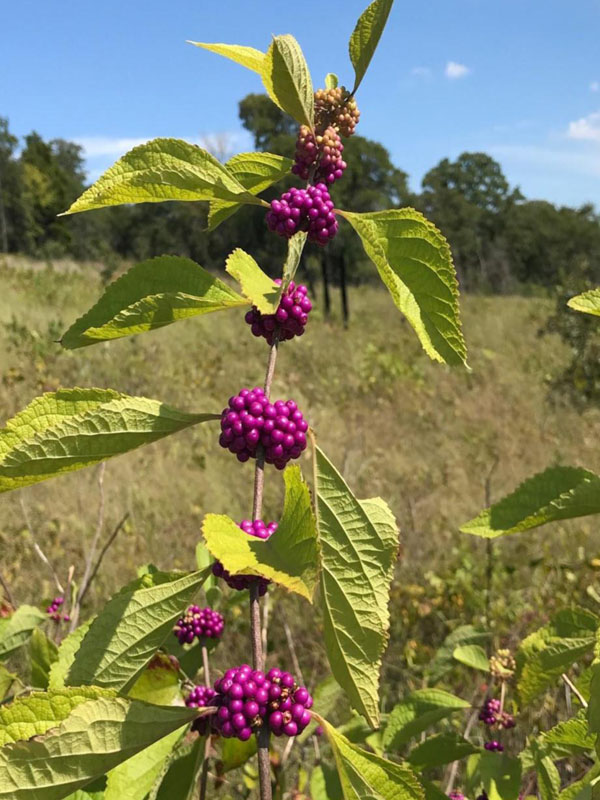
American Beautyberry
Field Identification Characteristics
Vegetative
Long, arching branches
Leaves oval, pointed and serrated
Fine hairs on twigs; bark light gray-brown to gray
Floral
Purplish-red clusters of spherical fruits around where leaves attach
Leaf and Stem Characteristics
Leaf Type: Simple
Leaf Arrangement: Opposite
Leaf Blade Edge: Serrated
Leaf Blade Edge: 6-15 centimeters
Growth Form: Shrub
Floral Characteristics
Petal Number: 4-5
Flower Color: Pink
Flower Timing: June-August
Fruit Type: Drupes
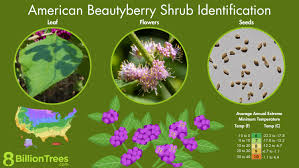
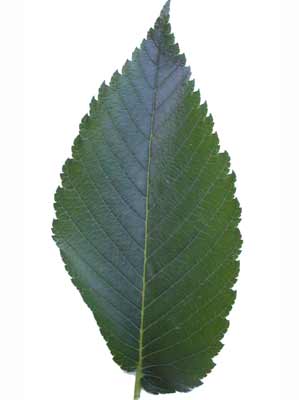
American Elm
Field Identification Characteristics
Vegetative
Massive trunks with arching branches; slender twigs
Alternating oval leaves; serrated
Bark gray and deeply furrowed in scaly ridges
Floral
Seed encased in flat, papery hull edged in hairs
Flat, papery round fruits
Leaf and Stem Characteristics
Plant Height: 80-foot diameter, 120-foot height
Leaves: Alternate, simple, ovate-oblong, 3-6 inches long, 1-3 inches wide, unequal at base, doubly serrate
Growth Form: Tree
Leaf Type: Simple
Leaf Arrangement: Alternate
Leaf Blade Edge: Double-serrated
Leaf Blade Length: 7-15 centimeters
Floral Characteristics
Petal Number: 0
Flower Color: Green or reddish
Flower Timing: March-April
Fruit Type: Samara
Field Identification Characteristics
Vegetative
Large deciduous tree with arching branches
Leaf and Stem Characteristics
Plant Height: 80-120 feet
Growth Form: Tree
Floral Characteristics
Petal Number: 0
Fruit Type: Samara

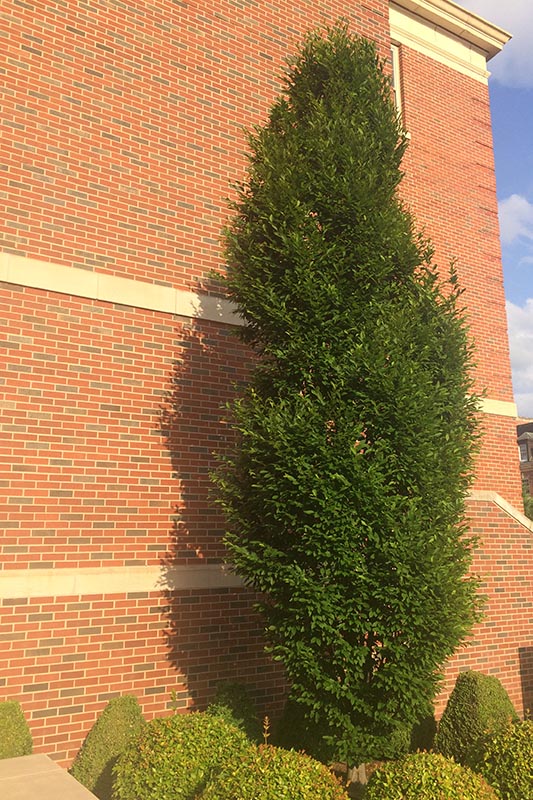
Hornbeam
Bark:
Smooth, thin, gray to bluish-gray bark that develops fluted, muscle-like ridges, giving it the nickname "musclewood".
Leaves:
Alternate, simple, ovate to elliptic.
Doubly serrated (toothed) margins.
Dark green above, paler below.
Leaves turn yellow, orange, or red in the fall.
Flowers:
Unisexual, in catkins (hanging clusters of tiny flowers).
Both male and female catkins on the same plant (monoecious).
Fruit:
Small nutlets (seeds) attached to three-lobed, wing-like bracts.
Nutlets are held in drooping, chain-like clusters.
Form:
A small to medium-sized tree or large shrub, often with a rounded crown.
Can have a wide-spreading, flat-topped crown.
Habitat:
Often found in moist, rich soils along streams, in bottomlands, and in woodlands.
Can tolerate some shade.
Other Names:
Musclewood, Blue Beech, Water Beech.
Distinguishing from European Hornbeam:
European hornbeam has curved buds, while American hornbeam has straight buds. A deciduous tree with smooth, fluted bark and serrated leaves that change color in autumn.
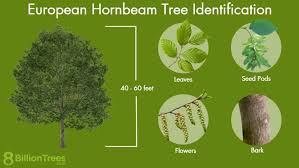
American Sycamore
Bark:
Young trees have smooth, light-colored bark, but as they mature, the bark peels off in large flakes, revealing a smooth, lighter-colored (white to creamy white) bark underneath.
The bark is often described as having a "camouflage" pattern, with patches of brown, green, tan, and white.
The bark on older stems is gray-brown and scaly.
Leaves:
Sycamore leaves are large, broad, and palmately lobed, resembling maple leaves.
The leaves are typically smooth and leathery.
The edges of the leaves are serrated.
Form:
American sycamores are large trees with a massive trunk and a broad, spreading crown.
They can grow to 75-100 feet tall, sometimes even taller.
The branches are often crooked and heavy.
Location:
Sycamores are often found in riparian zones, near rivers, streams, and wetlands, where they thrive in moist, fertile soil.
Fruit:
Sycamore trees produce round, green (later brown) seed "pods" that are smaller than a golf ball.
The fruit is a ball of elongated achenes borne singly on long stalks.
Twigs:
The twigs are zigzagging, with the bud causing a change in direction.
Buds:
Sycamore buds are divergent and resinous with a single cap-like scale.
Leaf scar surrounds bud, and stipule scar encircles twig.
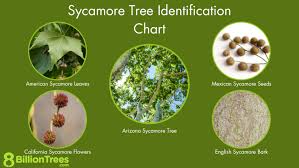
Bald cypress
Growth Habit:
Bald cypress trees are typically pyramidal in shape, especially when young, but can become flat-topped with age.
They are known for their ability to grow in water, with "knees" (aerial roots) often forming when submerged.
Foliage:
Leaves: The leaves are needle-like, but unlike other conifers, they are deciduous, meaning they fall off in the autumn, leaving the tree bare for the winter.
Color: The needles are a light green, but turn a beautiful yellow or copper-red in the fall before falling off.
Arrangement: The needles are arranged in a feather-like pattern along the twigs, making them appear soft and delicate.
Bark:
The bark is reddish-brown and fibrous, peeling away in long strips as the tree matures.
Cones:
Bald cypress cones are small, round, and greenish when young, turning brown and woody as they mature.
They are typically about 1 inch in diameter and have a wrinkled appearance.
Knees:
"Knees" are cone-shaped root structures that emerge from the base of the tree when it's growing in water.
These structures help the tree breathe and survive in saturated soil.
Habitat:
Bald cypress trees are native to the southeastern United States, often found in swamps, floodplains, and other wet areas.
Size:
Bald cypress trees can grow to be very large, reaching heights of up to 120 feet (36.5 meters).

Bitternut Hickory
Buds: The most reliable identification feature is the bright yellow, elongated buds that are present from mid-summer to early spring.
Leaves: Bitternut hickory leaves are pinnately compound, meaning they have multiple leaflets attached to a central stalk. They typically have 7-11 narrow, toothed leaflets that are bright green and turn golden yellow in autumn.
Bark: The bark is light gray to silvery gray and develops a network of small ridges as the tree matures.
Nuts: The nuts are small, almost round with a sharply pointed tip, and are enclosed in a thin, scaly husk that splits about halfway down. The kernel is bitter, hence the name "bitternut".
Habitat: Bitternut hickory is commonly found in rich, moist woods, and along stream banks.
Twigs: Twigs are slender and green, and have distinctive yellow buds.
Bark: Bark is light grayish-brown, and does not split deeply enough to flake.
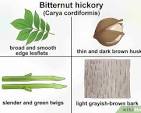
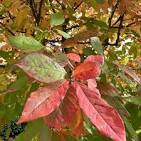
Black gum
Bark: Gray to brown or black, deeply grooved, with ridges broken into irregularly shaped blocks resembling "alligator hide".
Leaves: Alternate, simple, pinnately veined, oblong to obovate in shape with entire margins (smooth edges) or occasionally shallow lobes or coarse teeth near the tip. They are dark green above and slightly paler below, and can be 2-6 inches long.
Branches: Branches tend to grow out horizontally, almost at a 90-degree angle to the trunk, which is a good characteristic for identification, especially in winter.
Fruit: Small, bluish-black drupes that ripen in late September and early October.
Fall Color: Black gum is known for its vibrant fall color, displaying shades of yellow, orange, bright red, purple, and scarlet.
Habitat: Black gums can be found in a variety of habitats, from moist, well-drained soils to dry upland sites, and are native to eastern North America.
Scientific Name: Nyssa sylvatica.
Other Common Names: Black tupelo, sour gum, pepperidge
Bark: Gray to brown or black, with deep grooves and irregular blocks resembling "alligator hide".
Leaves: Alternate, simple, pinnately veined, oblong to obovate, dark green above and paler below, 2-6 inches long.
Branches: Grow horizontally, almost at a 90-degree angle to the trunk, aiding identification in winter.
Fruit: Small, bluish-black drupes ripening in late September and early October.
Fall Color: Displays vibrant yellow, orange, red, purple, and scarlet shades.
Habitat: Found in diverse habitats, from moist, well-drained soils to dry uplands, native to eastern North America.
Black Cherry
Bark:
Young Trees:
Smooth, reddish-brown with conspicuous, horizontal lenticels (small, light-colored spots).
Mature Trees:
Dark brown to nearly black, and scaly with upturned edges, often described as resembling "burnt potato chips" or "burnt cornflakes".
Leaves:
Shape: Simple, alternate, oval or oblong, with a pointed tip.
Margins: Finely toothed (serrated).
Surface: Dark green and shiny above, paler below.
Pubescence: Rusty-brown hairs along the midrib on the underside of the leaf.
Fall Color: Yellow to yellowish-red.
Flowers:
Appearance: Small, white flowers in hanging, narrow clusters (racemes).
Blooming Time: Late spring.
Fruit:
Type: Round, shiny, dark red to black drupe (a fleshy fruit with a single seed).
Ripening Time: Late summer to early fall.
Taste: Bitter-sweet.
Twigs:
Appearance: Slender, reddish-brown, sometimes with a grayish coating.
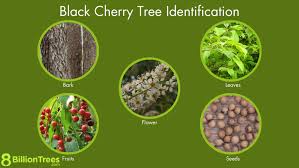
Black Hickory
Leaves:
Arrangement: Alternate, pinnately compound.
Leaflets: Typically 5 to 7, lance- to pear-shaped, 3-6" long.
Leaf undersides: Often have tan to rust-colored hairs.
Leaf stalks: With rusty hairs and tiny scales.
Bark:
Color: Dark gray to black.
Texture: Tight, not scaly, with irregular blocky ridges and deep furrows.
Young trees: Smooth gray bark when young.
Nuts:
Shape: Globe or pear-shaped.
Size: 1¼–2 inches long.
Husk: Thin, brown, covered with yellow scales.
Kernel: Small, round, sweet, edible. Leaves: Alternate, pinnately compound, with typically 5 to 7 lance- to pear-shaped leaflets, 3-6 inches long, often featuring tan to rust-colored hairs on the undersides. Bark: Dark gray to black, tight and not scaly, develops irregular blocky ridges and deep furrows. Young trees display smooth gray bark.